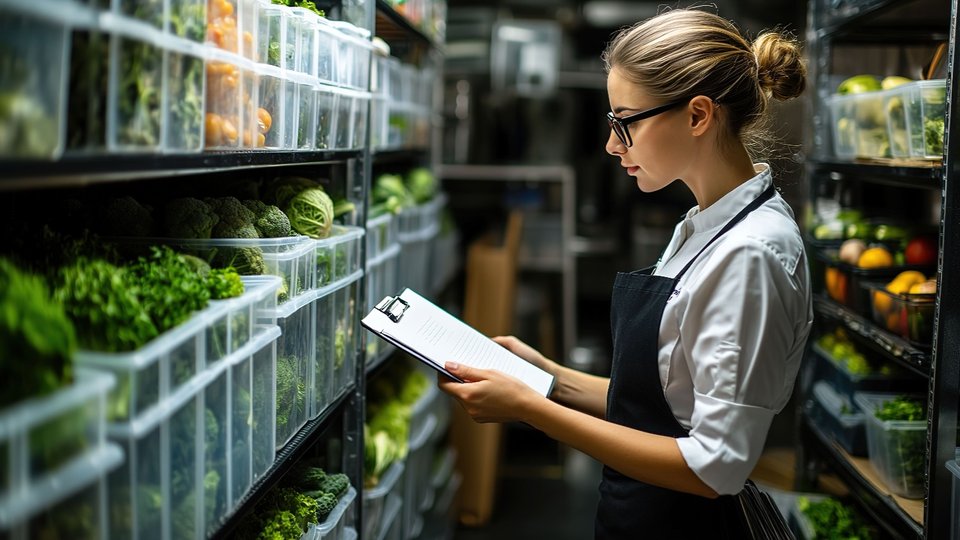Operations
No more stock surprises: How AI is changing food service inventory
Artificial Intelligence (AI) is transforming outdated, error-prone manual processes for food service inventory management by automating stock counts, increasing accuracy, reducing waste and providing a competitive advantage.

October 3, 2025 by David Greschler — Co-Founder & CEO, NomadGo
Let's paint a picture: It's a busy night at your restaurant. Mobile orders are flying in, the drive-thru line is wrapped around the building, and suddenly you're running low on a core ingredient. Before you can adjust, the kitchen is scrambling, orders are getting backed up, and customers are becoming increasingly frustrated.
Busy nights happen, but without proper inventory management, this nightmare scenario can quickly become a recurring problem. Running out of an ingredient isn't just inconvenient. It's costly. It means lost revenue, wasted food, and damaged customer loyalty.
Yet inventory management remains one of the industry's most outdated, time-consuming and error-prone tasks. Even when done correctly, traditional manual inventory tracking averages just 80–85% accuracy. In an industry where margins are everything, inaccuracies in inventory add up fast. If you over order, that leads to waste. If you are under order, that leads to missed sales. Either way, these issues impact profitability, efficiency, and the customer experience.
That's why many restaurant operators are turning to artificial intelligence (AI) to help boost operational performance. A recent Deloitte study found that eight in 10 restaurant executives are investing in AI to enhance customer experience and streamline operations – especially inventory management. In fact, 55 percent report using AI in inventory management daily, with another 25% currently testing those applications. With AI helping restaurants stay ahead of shortages and errors, it's worth taking a closer look at why inventory management is so crucial.
Why strong inventory management matters
The goal of good inventory management is simple — avoid key ingredients running out of stock. That means accurately tracking every ingredient from the moment it enters the kitchen until it's served.
For decades, the food service industry has relied on manual counting for inventory management. An inefficient and time-consuming process. When the inventory count is not accurate, it has a ripple effect beyond a restaurant's backroom. The inaccuracies flow through the supply chain, impacting labor efficiency and sales forecasting.
But maintaining the level of accuracy needed is incredibly difficult with traditional methods. Most restaurants still rely on clipboards, spreadsheets and long, late-night shifts to count inventory. And even a single mistake can snowball into overstocking, waste, or empty shelves. Manual counts also divert staff from daily operations, increasing labor costs and reducing productivity. The task is repetitive and exhausting, which only heightens the chances of mistakes.
A smarter way forward
This is where AI comes in.
Instead of spending hours manually counting inventory, employees can now rely on AI-powered handheld devices to automate the process. With a quick scan, this technology recognizes products, measures quantities, and updates stock levels in real time. Powered by computer vision, 3D spatial intelligence and augmented reality (AR), the technology transforms a tedious back-of-the-house task into a fast, intuitive workflow.
Beyond the stockroom, AI also delivers a broader view. Real-time inventory data across multiple locations helps identify trends, standardize best practices, and optimize procurement at scale.
The impact is immediate: inventory checks that once took hours can now be completed in minutes, with accuracy rates above 85%. That means fewer errors, less waste, and better-informed purchasing decisions.
Real benefits of AI inventory management
By integrating AI into handheld devices, inventory checks become fast and intuitive by automating the process. This technology isn't replacing employees; it's designed to empower them. By streamlining the inventory process, employees can spend more time focused on service and the customer.
The benefits of AI-powered inventory include:
- Increased visibility: Track inventory down to the SKU in real time.
- More frequent counts: Capture inventory more often for faster, more precise replenishment.
- Data-driven decisions: Leverage historical and live data to optimize purchasing, detect shrinkage, and adjust purchasing decisions proactively.
- Smarter labor use: Cut time spent on manual counts, lowering labor costs and boosting productivity.
- Reduced waste: Forecast demand accurately to minimize spoilage and overproduction.
A competitive edge
The food service industry is moving toward a future where the phrase "out of stock" is preventable. AI won't solve every challenge, but it will give operators the visibility and precision they need to respond faster and smarter.
This shift will create a more consistent customer experience, stronger trust and loyalty and free employees to focus on engaging with guests rather than managing back-of-the-house tasks.
As AI tools become more accessible, the gap will widen between restaurants that adopt them and those that continue to use manual methods. The businesses that come out ahead will be the ones who can see what's happening in their inventory in real time.
The bottom line
Inventory management may not be glamorous, but with AI it can be faster, more accurate, and a whole lot less painful. And for restaurants, it's a real competitive advantage. In an industry where every dollar and every minute counts, AI is a game-changer. By automating inventory, restaurant operators can streamline inventory processes, cut costs, and reallocate valuable time to focus on what matters most: delivering a great customer experience every time.
About David Greschler
David Greschler is a serial entrepreneur with over 30 years of experience building and leading successful tech ventures, including Softricity (acquired by Microsoft). As CEO and co-founder of NomadGo, he is transforming inventory management through AI, spatial vision, and augmented reality to make the process faster, more accurate, and easier to use. Known for his strength in product strategy and go-to-market execution, David holds seven patents and has a track record of launching category-defining innovations that simplify complexity and drive real-world impact.




